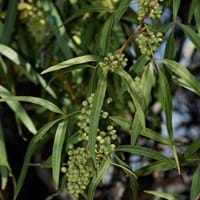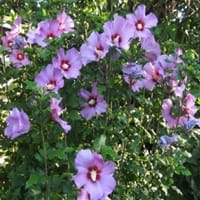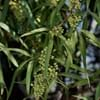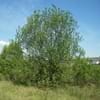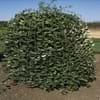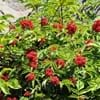Life Span
Not Available
Perennial
Origin
Southern Africa, South Africa
Australia
Types
Not Available
Not available
Number of Varieties
Not Available
Habitat
Forest margins, Grassland, Mountains, Pastures, Rocky Ridges, Woods
subtropical regions, Temperate Regions, Tropical regions, Warmer regions
USDA Hardiness Zone
8-11
9-11
Sunset Zone
8, 9, 12, 13, 14, 15, 16, 17, 18, 19, 20, 21, 22, 23, 24
H1, H2, 13, 14, 15, 16, 17, 20, 21, 22, 23, 24
Habit
Spreading
Upright/Erect
Flower Color
Light Green, Ivory
Blue, Purple, Blue Violet
Flower Color Modifier
Bicolor
Not Available
Fruit Color
Yellow, Red
Not Available
Leaf Color in Spring
Green
Dark Green
Leaf Color in Summer
Dark Green
Dark Green
Leaf Color in Fall
Dark Green
Dark Green
Leaf Color in Winter
Dark Green
Dark Green
Leaf Shape
Lance shaped
Irregular
Plant Season
Spring, Summer, Fall, Winter
Spring, Summer, Fall, Winter
Sunlight
Full Sun, Partial Sun, Partial shade
Full Sun
Growth Rate
Medium
Medium
Type of Soil
Loam, Sand
Clay, Loam, Sand
The pH of Soil
Neutral, Alkaline
Acidic, Neutral, Alkaline
Soil Drainage
Well drained
Well drained
Bloom Time
Early Spring
Indeterminate
Tolerances
Pollution, Drought
Not Available
Where to Plant?
Ground
Ground, Pot
How to Plant?
Seedlings, Stem Planting, Transplanting
Seedlings, Semi-hardwood cuttings
Plant Maintenance
Medium
Medium
Watering Requirements
Form a Soil ring to water efficiently, Use and maintain water-efficient soaker hoses, Use Mulches to help prevent water loss during hot and windy weather, Water Deeply
Average Water Needs, Do Not over Water, Requires regular watering
In Summer
Lots of watering
Lots of watering
In Spring
Moderate
Moderate
In Winter
Average Water
Average Water
Soil pH
Neutral, Alkaline
Acidic, Neutral, Alkaline
Soil Type
Loam, Sand
Clay, Loam, Sand
Soil Drainage Capacity
Well drained
Well drained
Sun Exposure
Full Sun, Partial Sun, Partial shade
Full Sun
Pruning
Prune if you want to improve plant shape, Remove damaged leaves, Remove dead leaves, Remove dead or diseased plant parts
Remove damaged leaves, Remove dead branches, Remove dead leaves
Fertilizers
All-Purpose Liquid Fertilizer
All-Purpose Liquid Fertilizer
Pests and Diseases
Red blotch
Red blotch, Rust aphids
Plant Tolerance
Drought
Not Available
Flowers
Insignificant
Yes
Flower Petal Number
Single
Single
Foliage Texture
Fine
Medium
Foliage Sheen
Glossy
Matte
Attracts
Birds
Butterflies, Flying insects, Hummingbirds, Insects
Allergy
no allergic reactions
Not Available
Aesthetic Uses
Not Used For Aesthetic Purpose
Borders, Showy Purposes, small hedge
Beauty Benefits
Not Available
Not Available
Environmental Uses
Air purification
Air purification
Medicinal Uses
Diarrhea, Dysentry
High blood pressure, lowering blood pressure
Part of Plant Used
Flowers, Leaves
Flowers, Leaves
Other Uses
Culinary use, Employed in herbal medicine, Used as a dye, Used as a spice, Used in paper industry, Wood is used for making furniture
Decoration Purposes
Used As Indoor Plant
No
Yes
Used As Outdoor Plant
Yes
Yes
Garden Design
Screening / Wind Break, Shade Trees, Street Trees, Topiary / Bonsai / Espalier
Container, Feature Plant, Hedges, Mixed Border, Rock Garden, Wall
Botanical Name
RHUS lancea
ALYOGYNE huegelii 'Monle'
Common Name
African Sumac
Blue Hibiscus, Purple Delight Blue Hibiscus
In Hindi
अफ्रीकी एक प्रकार का पौधा
Blue Hibiscus
In German
African sumac
Blauer Hibiskus Baum
In French
sumac africaine
Bleu Hibiscus Arbre
In Spanish
zumaque africano
Azul árbol del hibisco
In Greek
Αφρικανική σουμάκι
Μπλε Hibiscus Tree
In Portuguese
sumac africano
Árvore azul do hibiscus
In Polish
afrykański sumaka
Niebieski Hibiscus Drzewo
In Latin
African sumac
Hibiscus lignum blue
Phylum
Not Available
Magnoliophyta
Class
Not Available
Magnoliopsida
Order
Sapindales
Malvales
Family
Anacardiaceae
Malvaceae
Clade
Angiosperms, Eudicots, Rosids
Angiosperms, Eudicots, Rosids
Tribe
Not Available
Hibisceae
Subfamily
Anacardioideae
Malvoideae
Number of Species
Not Available
Season and Care of African Sumac and Blue Hibiscus
Season and care of African Sumac and Blue Hibiscus is important to know. While considering everything about African Sumac and Blue Hibiscus Care, growing season is an essential factor. African Sumac season is Spring, Summer, Fall and Winter and Blue Hibiscus season is Spring, Summer, Fall and Winter. The type of soil for African Sumac is Loam, Sand and for Blue Hibiscus is Clay, Loam, Sand while the PH of soil for African Sumac is Neutral, Alkaline and for Blue Hibiscus is Acidic, Neutral, Alkaline.
African Sumac and Blue Hibiscus Physical Information
African Sumac and Blue Hibiscus physical information is very important for comparison. African Sumac height is 460.00 cm and width 460.00 cm whereas Blue Hibiscus height is 120.00 cm and width 120.00 cm. The color specification of African Sumac and Blue Hibiscus are as follows:
African Sumac flower color: Light Green and Ivory
African Sumac leaf color: Green
Blue Hibiscus flower color: Blue, Purple and Blue Violet
- Blue Hibiscus leaf color: Dark Green
Care of African Sumac and Blue Hibiscus
Care of African Sumac and Blue Hibiscus include pruning, fertilizers, watering etc. African Sumac pruning is done Prune if you want to improve plant shape, Remove damaged leaves, Remove dead leaves and Remove dead or diseased plant parts and Blue Hibiscus pruning is done Remove damaged leaves, Remove dead branches and Remove dead leaves. In summer African Sumac needs Lots of watering and in winter, it needs Average Water. Whereas, in summer Blue Hibiscus needs Lots of watering and in winter, it needs Average Water.
